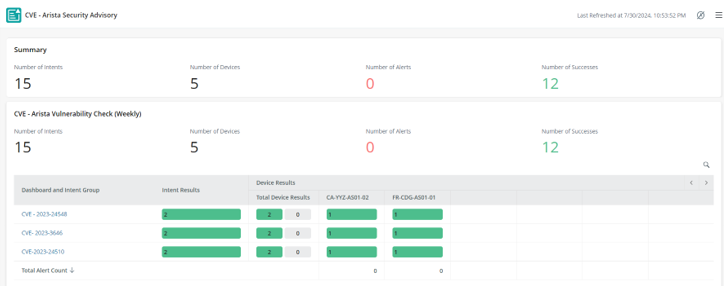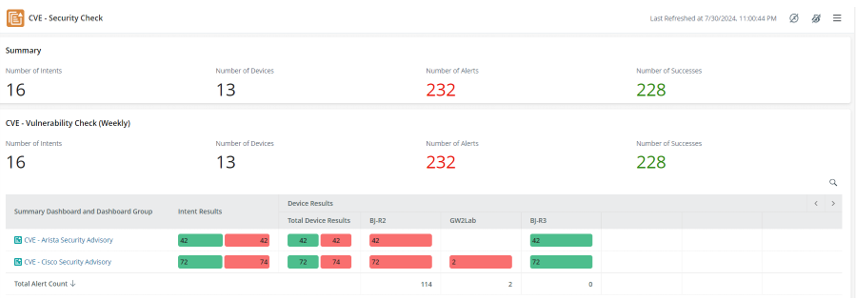Observability Dashboard
Observability Dashboard offers a comprehensive overview of the automation results for the entire network.
Observability Dashboard supports two data scopes, offering flexibility as each data scope can be applied to different scenarios.
-
Use intent dashboards as the data scope: Check Observability Dashboard Created with Intent Dashboards for its introductions and supported workflows.
-
Use other observability dashboards as the data scope: Check Observability Dashboard Created with Other Observability Dashboards for its major use cases.
Observability Dashboard Created with Intent Dashboards
While the Intent Dashboard observes specific network issues with details, the observability dashboard provides an overall view by displaying intent results from multiple intent dashboards. With observability Dashboard, you can group Intent Dashboards into widgets based on diagnosis purposes, and display intent results by device, site or device groups. You can use the observability dashboard to monitor critical information across thousands of devices and discover the root cause for issues in one view.

Major workflows supported by the observability dashboard:
-
Collaborative Troubleshooting: Build an observability dashboard to help collaborate with other engineers on network troubleshooting. In this case, each row inside the observability dashboard represents a diagnosis activity, and each column represents a device or a network, specifying where the issue happened. The red color indicates issues are happening.

-
Continuous Assessment: Build an observability dashboard to display the result from scheduled network assessment and catch the issues before active impact. In this case, each row inside the observability dashboard represents an assessment point, and each column represents a device or a network, specifying where the issue happened. The red color indicates there are problems found.

Observability Dashboard Created with Other Observability Dashboards
Observability Dashboard created with other observability dashboards helps organize and visualize different layers of data and provides a broader overview dashboard.
Users can create an observability dashboard with a hierarchy and provide the management team with an overview dashboard for the company-wide network, helping them to get a bigger picture for decision-making.
Two major use cases for this new type of observability dashboard:
- Provide a visually concise overview of the top 10 dashboards to streamline users’ understanding of network performance and security, eliminating the need to manually check each dashboard. When an alert emerges, users can view the specific drill-down report for identifying and addressing issues.
- Display data in multiple layers, adding depth to the information.
Example: Create a three-layer CVE dashboard to detect weaknesses in network devices at different levels.- Create an intent dashboard for each CVE ID. For example:
- Build the following intent dashboards to perform the CVE check for Arista devices: CVE-2023-24548, CVE-2023-3646, and CVE-2023-24510.
- Build the following intent dashboards to perform the CVE check for Cisco devices: CVE-2023-20048, CVE-2023-20198, CVE-2017-12240, and CVE-2018-0171.
- Create an observability dashboard for each vendor’s CVE. For example:
- Build an observability dashboard CVE - Arista Security Advisory with the intent dashboards created in step1a.

- Build an observability dashboard CVE - Cisco Security Advisory with the intent dashboards created in step 1b.

- Build an observability dashboard CVE - Arista Security Advisory with the intent dashboards created in step1a.
- Create an observability dashboard CVE - Security Check with two observability dashboards created in step 2 to monitor security issues for these two vendors.

With the CVE - CVE Security Check observability dashboard, users can see the overview of CVE - Arista Security Advisory and CVE - Cisco Security Advisory observability dashboards and can also easily navigate to the CVE intent dashboards and its drill-down reports.
- Create an intent dashboard for each CVE ID. For example: